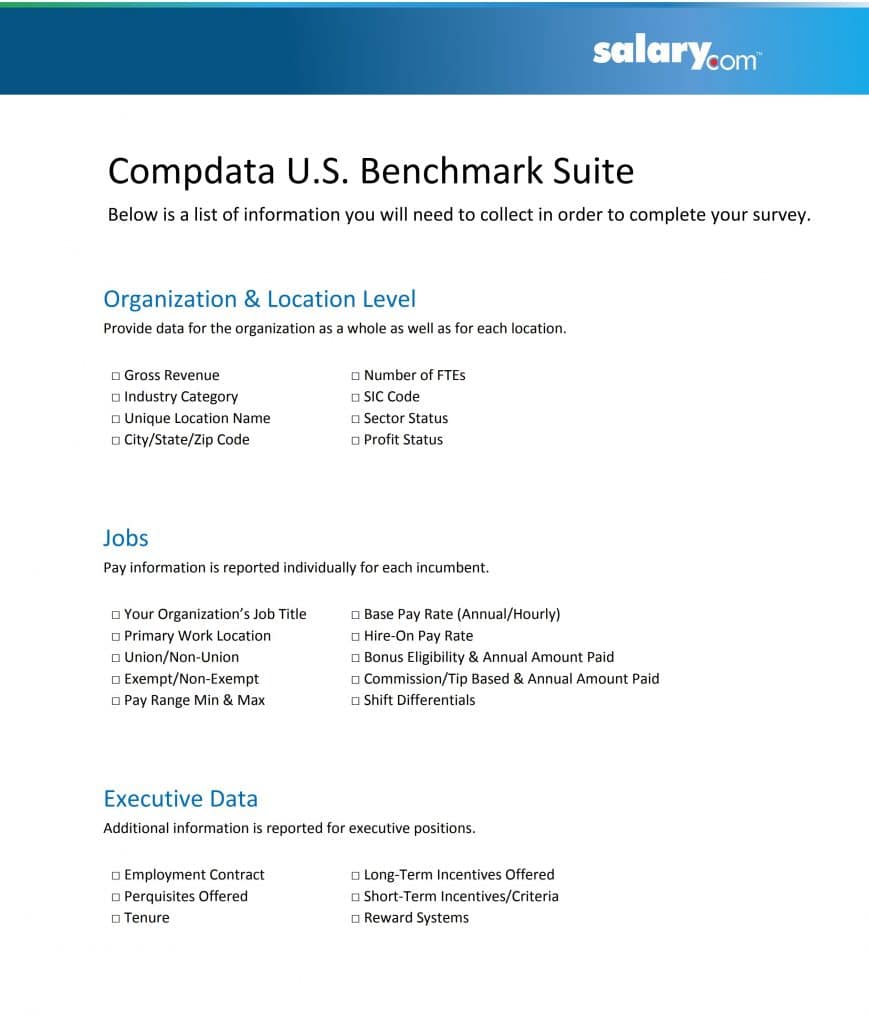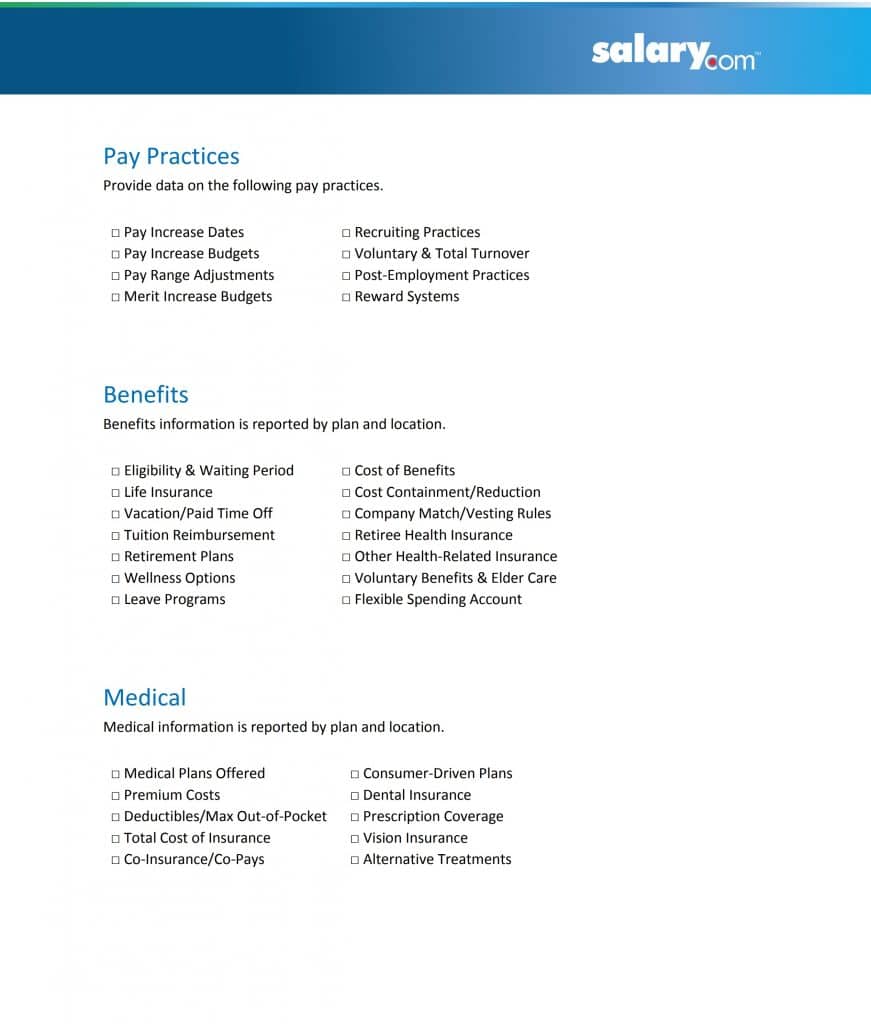Salary Surveys 20|20: How to Participate in a Salary Survey
Written by Jonathan Sweet
July 20, 2020

Participation in salary surveys is a critical function of HR and compensation professionals. By participating you are encouraging others to join, contribute their data and be a part of the community. This promotes a robust data source for you and the entire group of participants which in turn allows you to make better and more informed pay decisions.
Participating in a salary survey involves filling out a vendor’s questionnaire. Initial participation in a vendor’s survey can sometimes be challenging and time-consuming. In this post, the second in our five-part series “Salary Surveys 20|20,” we’ve outlined what you need to know to make the participation process a smooth one.
Know the deadline
The key is to know the deadlines for participation and what resources you have at your disposal. Length of time to complete depends on the number of positions surveyed and the amount of information requested for each incumbent. It can also depend on how readily that data is available and if you or someone at your organization has access to, and can retrieve data from your company ERP, HRIS or payroll systems.
Ask for a salary survey checklist
Ask your survey provider if they have a checklist (like the one shown below) to prepare yourself and others on what types of data will be requested and collected and what systems you may need access to.


Focus on job matching
Reputable surveys will provide job matching guidance to participants in addition to their function and level guidebooks. Many provide live support during and after the participation process has completed.
As an organization you should target between a 70-80% match between the survey job and your company job. When evaluating jobs, be sure to compare job descriptions and not job titles. Keep in mind not every organization has consistent job titles, let alone formal job descriptions. A job title and description in one organization could be significantly different at another organization. Overall, a survey job description should list the primary job function in a short summary paragraph. Descriptions should include duties and responsibilities, ideally, years of experience, degree, certifications (if appropriate) as well as reporting relationships. Salary survey descriptions are intentionally broad and typically designed to fit into a company’s wide definition of their job so you should find a match without much trouble.
How to participate with limited bandwidth and budget
For some organizations with limited resources, participating in a salary survey can seem like a daunting task. It does not have to be.
- Relationship/communication: Long-time and first-time participants should always look to build a relationship with their survey partners. Survey submission extensions are common and, in some cases, built into the survey schedule. Make sure you communicate with your survey partner and let them know if you are going to miss a deadline. Do not rely on your survey partner to track you down to remind you. Data collection calls are probably the most dreadful part of a survey team’s job; they hate making that call just as much as you hate receiving it.
- Alternatives to questionnaires and input files: Input files from ERP, HRIS, and payroll may be acceptable in satisfying (at least part of) your requirements for participation. For new participants this is especially helpful to jump start the data submission process. There are however downsides to this approach that the participant should be aware of. Vendors who rely exclusively on simple file exchanges, scheduled feeds or “integrations” with a 3rd party system of record (API or otherwise) may only partially complete their participation obligation. Deeper, total rewards datasets may follow a format or require detail above and beyond what is captured in an HRIS or payroll file (i.e., benefits/perquisites, and other pay types). Finally, be aware, data integrations although convenient, can by themselves fail, require costly maintenance and upkeep, leave an organization vulnerable and present risk of passing incorrect or incomplete data back to the vendor.
Other alternatives include competitor 3rd party salary surveys. Yes, that’s right many vendors will accept input and match files completed for other survey partners. Now, some charge for this matching service but a few (like Salary.com) provide this service complimentary. This might be one of the quickest ways to get up and running in a new salary survey. If going this route keep in mind the survey partner will need some information beforehand such as version of survey and source materials to effectively cross-map.
- Industry associations and Chamber of Commerce: Industry associations and your state and Chambers of Commerce may also have partnerships with salary survey providers. Often these associations extend members low to no cost surveys through a partner as a member benefit. com for example works with health and hospital associations across the country and partners with SHRM and WorldatWork as well many state Chambers of Commerce.
- Flexibility on pricing, participation, and non-participation: Different survey partners will have their own internal policies on delaying or deferring payment as well as discounting. Perhaps you have no budget for (new) surveys this year. Offer to participate in the survey with the agreement to purchase later should budget dollars free up. Conversely if you have budget but do not have the time to participate by the submission deadline there is always the non-participant option offered by some survey providers. Now, there is usually a premium paid (think 2-4 times the participant price) but often that can be negotiated (for example) to include participation and a $0 fee in the years to follow. Survey partners are eager to work with you and generally flexible on pricing and terms.
- Groups, affiliations, and your network of peers: Introduce your Survey Account Manager/Sales Representative to affiliated companies, and your network. Much like an industry/trade or membership association, you can negotiate rates within a smaller group or inquire about a custom or “club survey” designed for you and your like-minded network of peers.
In our fifth and final post in the series we will provide a whole host of reasons surveys are worth investing your time and money in RIGHT NOW.
The Compdata and IPAS survey practice at Salary.com is one of the largest compensation data providers in the world with compensation and benefits data spanning 100 countries across 17 industry verticals. To learn more, contact us at 781-552-4596.


Download our white paper to further understand how organizations across the country are using market data, internal analytics, and strategic communication to establish an equitable pay structure.
Insights You Need to Get It Right











